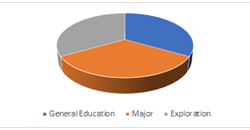Notes from the President
Chris Gray, Ph.D. | Founding President, Erie County Community College of Pennsylvania
EC3PA is built differently than the other institutions of higher learning here in Erie County. In these posts, we’ve discussed some of the differences, including who the college serves, how the college is organized and funded, and what a “typical” student looks like. This week, I’d like to share some information about the types of degrees the college awards.
EC3PA will award two major types of degrees: Associate of Applied degrees and Associate degrees. The applied degrees are designed to give students specific skills and to prepare them to join the workforce immediately upon graduation. We’ll discuss applied degrees in a future post, but for quick reference right now, welders, automotive technicians, RNs, CNC operators, and the like all are applied degree holders. This week, I’d like to focus on the associate’s degree, or what we call within the industry the transfer degree.
The associate’s degree is designed to prepare students to transfer to a four-year institution and then to complete a baccalaureate degree. There are numerous types of associate’s degrees, also; the Associate of Arts and Associate of Science are the most common, but for the sake of our discussion, we’ll discuss this class of degrees as a whole.
Since the associate’s degree is designed to transfer and to thus become a part of the baccalaureate degree, we’ll begin our exploration at the baccalaureate degree level.
A “typical” college degree consists of 120 credit hours of coursework and generally takes four years to complete. We create this calculation by assuming that a full-time student enrolls in fifteen credit hours each semester and thus will complete the baccalaureate degree in eight semesters or four years. However, much like there really is no “typical” community college student, there likewise really is no “typical” journey to obtaining a college degree, especially on the linear path and tight timeline that this model suggests! In fact, in a future entry, I’ll share some of the serious challenges and barriers that college and universities put in place that actually cause students to spend more time and money than they should and what we are doing at EC3PA to help keep students on track.
A baccalaureate degree can be broken into roughly three equal parts: general education courses, exploration courses, and major courses. Unfortunately, we tend to think of college degrees just in terms of the major and put too much pressure on students to think about what they will major in when they attend college. I’m guilty of this and often am tempted to ask students that I meet what they are studying. I need to work to change my own thinking since we know that more than eight out of ten — better than 80% — of students change their major in their first year!
The following less-than-impressive Excel chart (my apologies to graphic designers everywhere) is a visual representation of this general model of how undergraduate coursework is divided:

So how does an associate’s degree fit into this four-year baccalaureate degree? In essence, it covers half of the degree requirements. Associates degrees consist of sixty credit hours of instruction wherein general education courses make up the largest part of these transfer-oriented associate degrees. Community college students take around thirty-five to forty credit hours of general education classes in fields including math, science, English, communication, social and behavioral science, and humanities and fine arts. Our commonwealth has identified these areas as required courses for all colleges and universities, and EC3PA courses follow this model.
What do community college students take with the additional twenty to twenty-five credit hours needed to earn their associate’s degree? The answer is, as you may have guessed, is that it depends! Some students take the remaining hours in classes designed to prepare them for their future major. Some explore different subjects, trying to find their passion. In my personal experience as a community college student, I explored my passions both in math and theatre. I was a bit of an overachiever and graduated with more than seventy credit hours, but I went to my four-year institution having satisfied all of my general education requirements, almost half of my major requirements in theatre, and some of the requirements for my business minor. All of those math classes I took thinking I would major in math ended up counting towards my exploration credits (commonly referred to as elective courses). In fact, all of those community college credits allowed me to graduate in seven semesters — or three and a half years!
The associate’s degree fulfills the general education component of a baccalaureate degree and also gives students a healthy jump on their major and exploration credits as well. Students are afforded the opportunity to try out curricula, explore, change their minds, challenge themselves through a new discipline, or learn a specific skill that is of personal interest — all while getting halfway to a four-year degree!
I’ve painted with broad strokes here, and I am fully aware there are certain degrees to which this model does not apply as easily. Likewise, there are many cases where this model needs to be tweaked for students’ unique experiences. However, this model is nonetheless one that serves more than half of all college enrollees in the United States. EC3PA is working closely with guidance counselors in our local schools so that they, too, can understand how an associate’s degree works and share it with their students. It’s a powerful and often overlooked vehicle for student success, and it’s one that needs to be showcased with more frequency’s.
I’d love to hear your questions, ideas for future posts, or areas that need more explanation. Please feel free to reach out to me at president@ec3pa.org.
Yours in learning,
Chris

